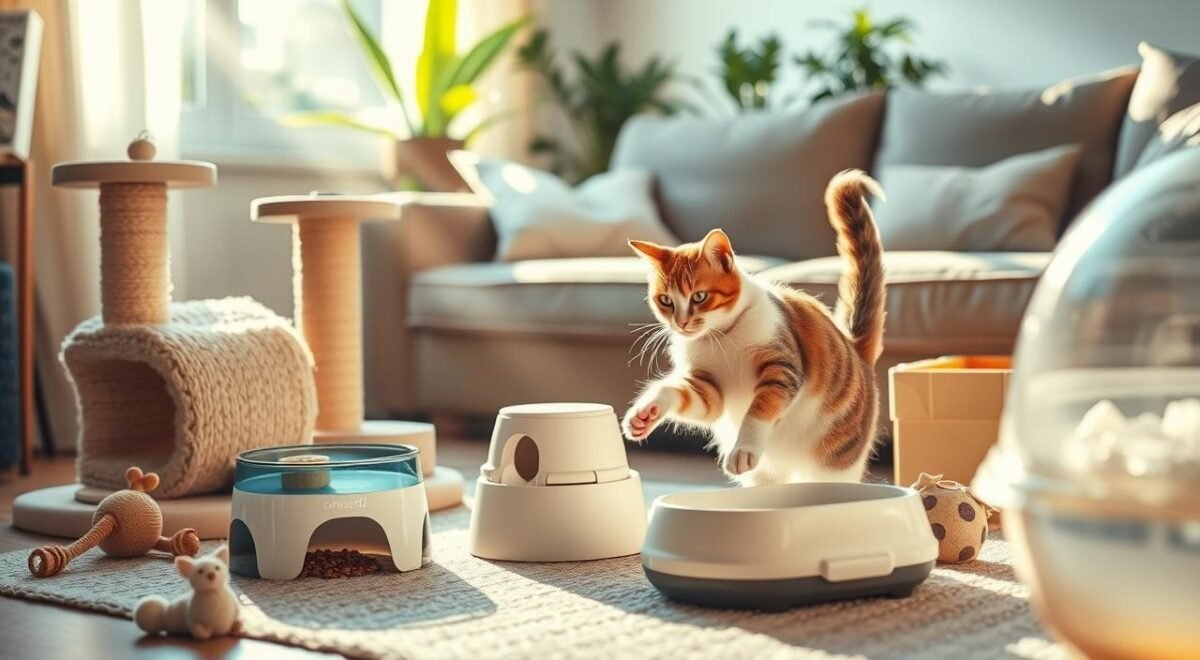Bringing a new cat into your home is thrilling and rewarding. But, it also brings big responsibilities. This guide will give you all the key info to keep your cat happy and healthy. We’ll talk about feeding, grooming, and making a safe home for your cat.
Key Takeaways
- Cats are relatively low-maintenance pets compared to dogs, making them suitable for busy lifestyles.
- Regular veterinary care, including vaccination and flea/worm treatment, is crucial for your cat’s health.
- Providing a comfortable living space, proper nutrition, and stimulation is essential for a cat’s well-being.
- Spaying or neutering your cat is recommended to prevent unwanted behaviors and health issues.
- Cats can coexist safely with children if proper guidelines are followed.
Basic Cat Care and Feeding Requirements
Proper cat nutrition is key for your cat’s health. Cats need animal-based proteins to stay healthy. Choose high-quality, brand-name cat food that matches your cat’s life stage.
Choosing the Right Cat Food and Portions
Cats need taurine for heart and eye health. Don’t give them baby food with onion or garlic powder, as it’s toxic. Keep portions small to avoid obesity. Wet food can help with hydration. Always check with your vet for your cat’s specific needs.
Water Requirements and Hydration Tips
Make sure your cat always has fresh, clean water. Cats can easily get dehydrated. Use multiple water bowls or a pet water fountain to encourage drinking.
Establishing Feeding Schedules
Set a regular feeding schedule for your cat. This helps keep them healthy. Feed at the same times every day. Treats should only be 5-10% of their diet to avoid weight gain.

Understanding your cat’s nutritional needs and setting healthy feeding times is important. It ensures your cat gets the care and food they need for a happy life.
Creating a Safe and Comfortable Living Space
It’s vital to make a safe and comfy home for your cat. When setting up cat housing, focus on what they like and need. Cats prefer clean, dry spots for sleeping, not near their litter box. Keeping indoor cats safe means using safety collars and microchips for easy ID.
To make your cat’s home better, add cat safety features like hiding spots and high places. Shelves or cat trees help them feel safe and in charge. Also, clean their bedding often to keep their space healthy and comfy.
- Provide a clean, dry place for sleeping and resting, away from the litter box.
- Use safety collars with ID tags or microchips to identify your indoor cat.
- Create hiding spaces and elevated areas like shelves or cat trees for your cat to feel safe and secure.
- Clean bedding regularly to maintain a healthy and comfortable living space.
To protect your furniture, give your cat scratching posts or boards. Also, make sure your home is cat-proof to keep it safe for your cat. With these tips, you can make a cozy and fun home that fits your cat’s special needs.

“Cats need a clean, comfortable, and stimulating living space to thrive. By catering to their natural instincts, you can create a safe and happy home for your feline companion.”
How to Take Care of a Cat?
Daily Care Routine and Essentials
Creating a daily routine is key for your cat’s happiness. It includes regular meals, playtime, and grooming. Cats like knowing what to expect, so keep their routine consistent.
Grooming and Hygiene Practices
Cat grooming keeps their coat healthy and reduces shedding. Brush or comb their fur a few times a week. This helps remove loose hair and prevents hairballs.
Trim their nails every 2-3 weeks to keep them comfortable. This also stops them from scratching furniture. Most cats don’t need baths, but a gentle rinse can help if they get dirty.
Litter Box Management
Good litter box care is vital for your cat’s hygiene and health. Have one litter box per cat, plus an extra one. Place them in quiet, easy-to-reach spots.
Scoop the litter box daily and clean it fully once a week. Choose a litter your cat likes and change it often. Cats usually use the litter box, but if they don’t, see a vet.
Also, give your cat scratching posts or pads. This meets their natural scratching urge. Trimming their nails and using deterrents on furniture can also help.
By sticking to these daily cat care tips, your cat will stay happy, healthy, and well-groomed.
Health Care and Preventive Measures
Keeping your cat healthy is very important. Regular vet visits and preventive care help a lot. Let’s look at the main parts of cat health care and preventive care for cats.
It’s good to take your cat to the vet every year or every six months. These visits help the vet check your cat’s health. They can also give important cat vaccinations to keep your cat safe from diseases. Keeping up with these vet visits is key for your cat’s health.
Dental care is also very important for cat health. You should get your cat’s teeth cleaned by a vet every 6 to 12 months. This helps stop gum disease and tooth decay, which can cause bigger health problems if not treated.
- Feline heartworm disease is getting more common, so preventive medication is a must for indoor and outdoor cats.
- Keeping your cat at a healthy weight and making sure they get enough exercise is important. It helps prevent obesity and other health problems.
- Using veterinarian-recommended products to fight parasites, like fleas and ticks, is crucial for your cat’s health.
By focusing on your cat’s health care and taking proactive steps, you can help your cat live a long, happy, and healthy life. Remember, catching health problems early and treating them quickly is very important.
Conclusion
Being a responsible cat owner means taking care of your cat’s health and happiness. You need to feed them right, take them to the vet, and make sure they have a safe place to live. A daily routine of grooming and keeping the litter box clean is also important.
This guide has given you the basics of caring for your cat. It talks about feeding schedules and keeping them healthy. Remember, every cat is different. You need to tailor your care to fit their special needs.
By focusing on your cat’s diet, cleanliness, and health, you can build a strong bond. This will make your cat a loving and loyal friend. With the right care, your cat will bring joy to your life for many years.
FAQ
What are the basic cat care and feeding requirements?
Cats need high-quality, brand-name food that matches their life stage. It should have taurine for heart and eye health. Always have fresh, clean water available. Treats should only make up 5-10% of their diet.
Don’t give them baby food with onion or garlic powder. Cats are meat-eaters and need animal-based proteins. Keep their portions small to avoid obesity. Wet food can help with hydration. Always check with a vet for the best diet for your cat.
How do I create a safe and comfortable living space for my cat?
Make sure they have a clean, dry spot for sleeping. Keep them indoors for their safety and health. Use safety collars with ID tags or microchips.
Set up hiding spots and places to climb like shelves or cat trees. Keep their sleeping areas away from litter boxes. Clean their bedding often. Use scratching posts or boards to protect your furniture. Cat-proofing your home is also a good idea.
What are the essential daily care routines and grooming practices for cats?
Brush or comb your cat regularly to reduce shedding and hairballs. Most cats don’t need baths. Handle them gently, supporting their body when lifting.
Grooming helps bond with your cat and can detect health problems early. Keep litter boxes quiet and easy to get to. Scoop daily and clean them weekly. Have one litter box per cat plus one extra.
Trim their nails every 2-3 weeks. Stick to a daily routine for feeding, play, and grooming.
What preventive health measures should I take for my cat?
Take them for annual vet check-ups and vaccinations. Spay or neuter them by five months to prevent health problems and unwanted behaviors. Never give them human medicine without a vet’s okay.
Keep the ASPCA Animal Poison Control Center number handy. Watch their weight and make sure they get regular exercise. Consider flea treatments, deworming, and dental care. Vaccines usually include FVRCP and rabies.
Look out for changes in behavior, appetite, or litter box habits. These can be signs of health issues.
Source Links
- https://icatcare.org/advice/thinking-of-getting-a-cat/
- https://www.safehavenforcats.org/news/the-ultimate-cat-supply-checklist/
- https://www.rspca.org.uk/documents/1494939/8736188/How to take care of your cat.pdf/5f61af7d-d09b-a643-122d-dd100d8ab19b?t=1550587168178
- https://www.aspca.org/pet-care/cat-care/general-cat-care
- https://www.petsafe.com/blog/cats-101-basic-health-care-tips-to-keep-your-cat-healthy/
- https://catfriendly.com/cat-friendly-homes/what-your-cat-needs-to-feel-secure/
- https://classactcats.com/blog/living-with-cats-in-small-spaces/
- https://www.rspca.org.uk/adviceandwelfare/pets/cats/environment
- https://www.wikihow.com/Take-Care-of-a-Cat
- https://www.dailypaws.com/cats-kittens/health-care/ways-to-keep-your-cat-healthy
- https://www.catcarecenter.com/services/cats/kitten-care
- https://www.catcarecenter.com/services/cats/veterinary-preventive-care
- https://vetster.com/en/wellness/preventative-wellness-tips-for-your-cat
- https://bettervet.com/resources/pet-health-care/how-to-take-care-of-a-cat
- https://bowmananimalhospital.com/blog/tips-for-new-cat-owners/






